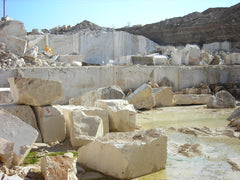
Natural stone has been the best alternative for floors and walls since the antiquity, and has never been out of fashion. Stone tiles bring the beauty of nature to our homes and add a character and warmth to a place which cannot be matched with any other material.
Because natural stone comes -by definition- out of nature, there can be huge variations in its color and texture, so it's important to be prepared before shopping for stone tiles for your homes or offices. Be sure to order enough quantity of the material to finish the job in one shipment, so that there will be minimum risk of color/pattern variation. It's also a good idea to get a case or two extra. If you need to do some repair work later, the particular stone you want may be unavailable.
The most common stone tiles are marble, granite, slate, travertine, limestone and sandstone. Which one should we choose?
MARBLE:
Marble used to be the choice of emperors, sultans and kings all around the world. Thanks to today's technology and widespread production, almost everyone has access to this beautiful stone. Although it's harder than travertine and limestone, it's still subject to scratches and stains: so extra attention is necessary when using marble.
Pros: Gorgeous colors, patterns and veins, stronger than travertine.
Cons: It can absorb water or other liquids, which results in stains. Extra care is needed especially when used outdoors.
Popular Uses: Living rooms, hallways, bathroom and kitchen walls and floors.
TRAVERTINE:
Travertine is one of the most popular stones. It's usually confused with marble or limestone, although it's different from either. While slightly softer than limestone and marble, it has a unique warmth and natural look.
Pros: Offers a vast variety of colors and patterns, and gives nice and soft feeling to floors.
Cons: Is prone to stains and scratches.
Popular Uses: Living rooms, hallways, bathroom and kitchen walls and floors.
LIMESTONE:
Limestone is another sedimentary stone which is harder than travertine. Due to its durability, it's a good choice for flooring. It resembles wood with linear striations forming in time.
Pros: Beautiful patterns and colors, very resistant.
Cons: As it absorbes water and other liquids, it's prone to stains so extra care needed if using outdoors.
Popular Uses: Living rooms, hallways, bathroom and kitchen walls and floors.
GRANITE:
Being the hardest of the natural stones used in home decoration, granite is an excellent choice in terms of resilience and versatality. Compared to marble and granite, it gives more of a cold and hard feeling, and needs regular cleaning to keep it smooth and shiny.
Pros: Beautiful colors and patterns, durability and resistancy to water makes it an excellent choice for indoor and outdoor flooring.
Cons: Gives a cold and neutral feeling, which makes it more suitable for commercial spaces, and/or countertops.
Popular Uses: Office floors and walls, bathroom floors, countertops.
SANDSTONE:
Sandstone is a sedimentary rock composed of rock grains and sand-sizedd minerals. Unlike other natural stones, it has less color variations which makes it easier to find consistent tones of the material.
Pros: Very resilient and few variations in colors.
Cons: Minimal color options.
Popular Uses: Living rooms, gardens, bathroom and kitchen floors.
SLATE:
One of the most common stones used in decoration, Slate is another metamorphic rock which can split into thin layers easily. However, when expertly cut, and if the density of the stone is high enough, it's a good choice for flooring as well as roofing.
Pros: Highly resilient, brings a natural look and feel to the surface applied.
Cons: Installation could be tricky, surface imperfections limits its usibility.
Popular Uses: Living areas, gardens, entryways, kitchens.